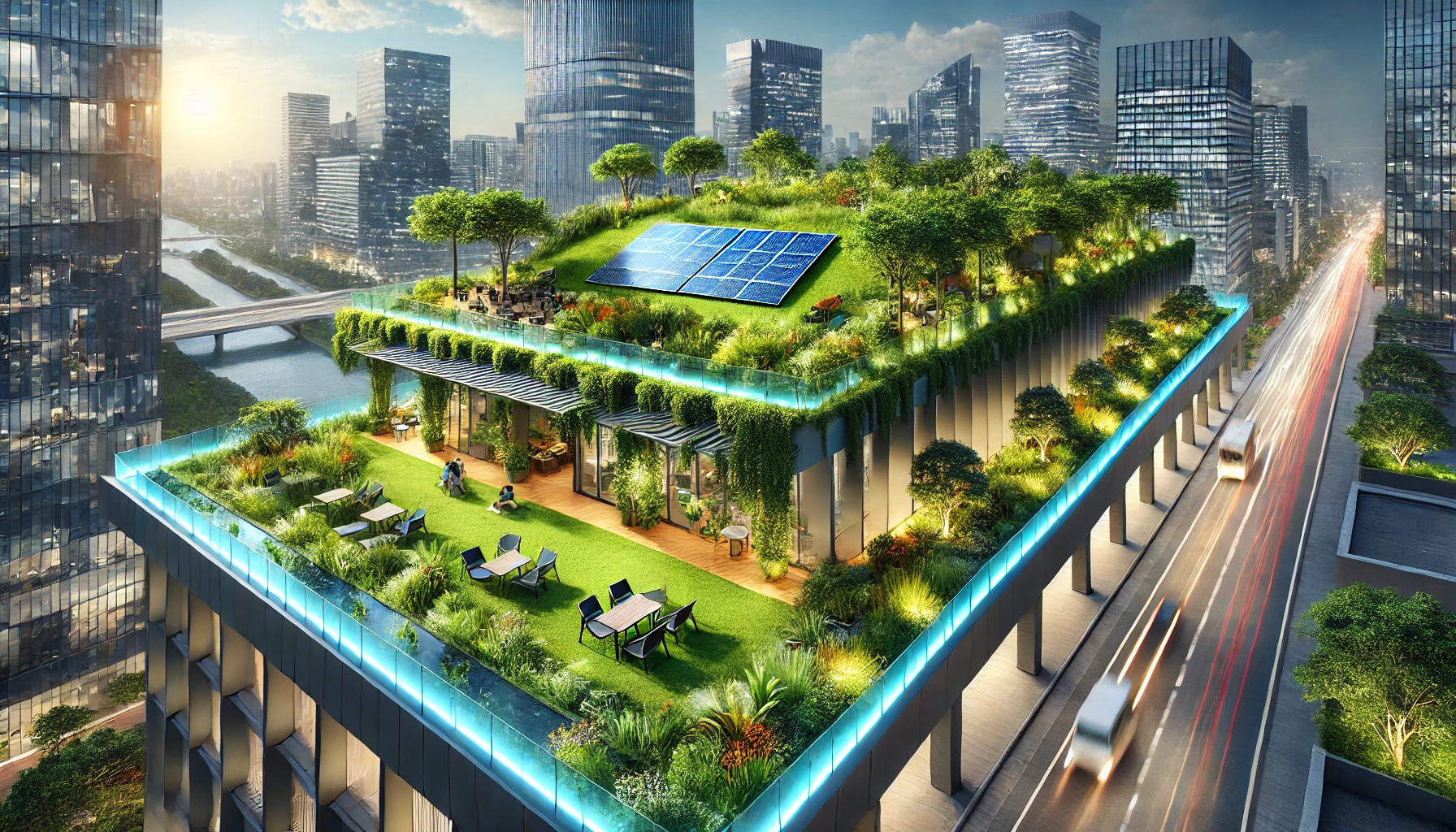Understanding Green Roofs
Green roofs, also known as vegetated roofs, are becoming an increasingly popular option for eco-conscious homeowners and businesses. These roofs are designed to support plant growth, providing numerous environmental, economic, and social benefits. But what exactly is a green roof? Essentially, it’s a roof that is wholly or partially covered with vegetation, soil, and a waterproof membrane. Green roofs can range from simple setups with drought-resistant plants to more complex designs with intricate landscaping and irrigation systems.
The Benefits of Green Roof Installations
Green roofs offer a multitude of advantages that make them an attractive option for urban and suburban environments. Below, we’ll explore some of the most compelling benefits:
- Environmental Benefits
- Improved Air Quality: Green roofs act as natural air filters, capturing airborne pollutants and dust particles. This helps reduce smog and improve the overall air quality in urban areas.
- Reduced Urban Heat Island Effect: By providing a layer of insulation, green roofs help lower ambient temperatures in cities, combating the urban heat island effect. This can lead to significant energy savings and improved comfort levels.
- Enhanced Biodiversity: Green roofs create habitats for various plant species, insects, and birds, promoting urban biodiversity and supporting ecosystems that are often disrupted by urban development.
- Economic Benefits
- Energy Efficiency: Green roofs provide excellent insulation, reducing the need for heating and cooling. This can lead to lower energy bills and a reduced carbon footprint for building owners.
- Extended Roof Lifespan: The protective layers of a green roof shield the underlying roofing materials from UV radiation, temperature fluctuations, and physical damage. This can significantly extend the lifespan of the roof, reducing maintenance and replacement costs.
- Increased Property Value: Properties with green roofs are often seen as more attractive and innovative, potentially increasing their market value and appeal to eco-conscious buyers.
- Social Benefits
- Aesthetic Appeal: Green roofs add natural beauty to urban landscapes, creating visually appealing spaces that can enhance mental well-being and provide a sense of tranquility.
- Community Spaces: Larger green roofs can be designed as communal gardens or recreational areas, fostering social interaction and community engagement.
- Noise Reduction: The vegetation and soil layers of green roofs help absorb sound, reducing noise pollution and creating quieter, more pleasant environments both inside and outside the building.
Critical Considerations for Green Roof Installations
While the benefits of green roofs are substantial, there are several important considerations to keep in mind before embarking on a green roof installation:
- Structural Requirements
- Load-Bearing Capacity: Green roofs add significant weight to a building’s structure. It’s crucial to ensure that the existing roof can support this additional load. Consulting with a structural engineer is essential to assess and possibly reinforce the roof’s load-bearing capacity.
- Waterproofing and Drainage: Proper waterproofing and drainage systems are critical to prevent water infiltration and damage to the building’s structure. A high-quality, durable waterproof membrane and effective drainage solutions should be integral components of the green roof design.
- Design and Plant Selection
- Climate and Environment: The choice of plants should be tailored to the local climate and environmental conditions. Drought-resistant and native plant species are often recommended for their resilience and lower maintenance requirements.
- Layer Composition: A typical green roof consists of several layers, including a root barrier, drainage layer, filter layer, growing medium, and vegetation layer. Each layer plays a specific role in ensuring the roof’s functionality and longevity.
- Maintenance and Upkeep
- Regular Maintenance: Green roofs require ongoing maintenance to ensure the health and vitality of the plants. This includes watering, weeding, fertilizing, and monitoring for pests and diseases.
- Irrigation Systems: Depending on the climate and plant selection, an irrigation system may be necessary to provide adequate moisture during dry periods. Automated irrigation systems can simplify maintenance and ensure consistent water supply.
Why Choose Green Roof Installations for Urban Areas?
Urban areas face unique environmental challenges, including heat islands, air pollution, and limited green space. Green roof installations offer a sustainable solution by transforming unused rooftop spaces into thriving ecosystems. Green roofs not only improve air quality and reduce temperatures but also provide essential habitats for urban wildlife. Investing in a green roof can significantly enhance the energy efficiency of buildings, leading to lower utility bills and a reduced carbon footprint. Additionally, the aesthetic and social benefits of green roofs contribute to healthier, more vibrant communities. By integrating green roof technology, cities can take a proactive step toward sustainability and environmental stewardship.
Examples and Tips for Successful Green Roof Installations
- Case Study: The Eco-Roof in Portland, Oregon
- Portland’s Eco-Roof initiative has seen over 1.3 million square feet of green roofs installed across the city. These roofs have helped manage stormwater, reduce the urban heat island effect, and promote biodiversity. The success of Portland’s program highlights the potential for other cities to implement similar initiatives.
- Tips for Homeowners and Businesses
- Start Small: For those new to green roofs, starting with a small section of the roof can be a manageable way to experience the benefits without a large initial investment.
- Choose the Right Plants: Select plants that are well-suited to the local climate and require minimal maintenance. Sedums, grasses, and wildflowers are popular choices for many green roofs.
- Hire Experienced Professionals: Working with experienced green roof designers and installers ensures that the project is executed correctly and meets all necessary building codes and standards.
Conclusion
Green roof installations offer a plethora of benefits, from environmental and economic advantages to social and aesthetic improvements. However, they also require careful planning, proper design, and regular maintenance to ensure their success and longevity. By understanding the benefits and considerations outlined in this article, homeowners and businesses can make informed decisions about incorporating green roofs into their properties. As we continue to seek sustainable solutions for urban living, green roofs represent a promising and impactful option for creating healthier, more resilient cities.

